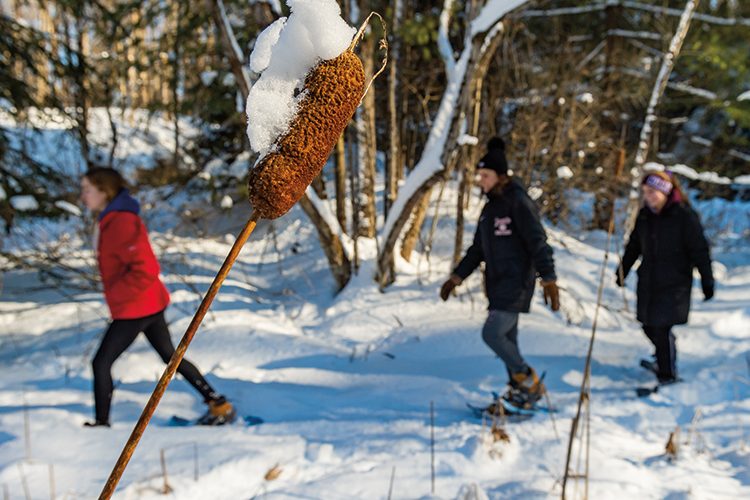It doesn’t take long. A short walk uphill from the Quad, and you’re in the woods. Being among the trees certainly boosts my mood — perhaps because I’m focusing on the moment and not the dramas of life. I listen to the creaking branches and crunching snow. I compare the textures of bark. There is a hint of wood smoke in the air. Time in nature engages all five senses. It also has measurable positive effects on physical and mental health. There is a reason “forest bathing” is now a thing.
If you commit to exploring the surrounding landscape in-depth, expanding your understanding of the diversity of organisms and how they interact, you’re likely to thrive in profound ways. E.O. Wilson argues that we have an inherent yearning to uncover the mysteries of nature, which he calls “biophilia.” Technology and modern ways of living can isolate us from nature. But overcoming barriers to our biophilic tendency holds many rewards: enhanced creativity, a stronger sense of place, and a realization of how much nature matters to us as individuals and to society.
For a decade and a half, I taught about a variety of social and environmental problems: plummeting biodiversity, widespread toxic pollution, and the crushing reality of climate change. But students’ eyes glaze over when the catalog of ills gets too long. It is not acceptable if they are left feeling hopeless instead of empowered. Addressing socio-environmental problems is critical, but it does not have to involve a narrative of sacrifice. In fact, it can make you happier.
In 2015, I decided it was time for a new approach, so I created The Geography of Happiness. In the course, students are challenged to think about their own life paths and habits. The evidence is clear. Be outside more. Cultivate strong social relationships. Share meals. Find a job that reinforces meaning. Meditate. Express gratitude. But the course’s main goal is to help students see how they, personally, have a stake in advancing sustainability; not just materially, but in a way that gives their lives deeper meaning. Sustainability is not just about protecting the environment. It is about helping people to improve their lives. Using examples from near and far, students learn about the environmental and social conditions that are most likely to enhance individual happiness and promote overall well-being. Thoreau’s celebration of the farmer as hero. How right-to-roam laws in Europe promote health, strong relationships, and land stewardship. How investing in green energy creates jobs, reduces pollution, and leads to what Bill McKibben calls a “durable future.” And how once you’ve achieved a middle-class salary, more income doesn’t buy you more happiness.
Recently, I took the class snowshoeing. We timed the outing perfectly — a crisp 12- degree day, with deep snow and lots of sun. Getting outside as a group — in addition to meditation sessions at Chapel House and cooking and eating together in ALANA Cultural Center — has great effects on class dynamics. Such activities help build trust and lead to honest reflection in
class discussion.
Beyond shared experiences, students are required to spend 15 minutes in each of four landscapes around Hamilton — the Village Green, a groomed recreational space (e.g., the golf course), farmland, and deep woods — alone and without a phone. They then write about the experience, and it often leads to some powerful insights. Students are embarrassed about being seen alone. They are anxious when they can’t check their phones. Some are nervous about being in the woods by themselves. But they end up celebrating the experience. They develop mindfulness about Hamilton’s history, people, and environment. Unplugged, they slow down and notice details they had been too distracted to perceive before. They feel connected to the place.
I have now taught the class four times. Some course alumni have told me that it has helped them choose alternative careers, end toxic relationships, negotiate serious illness, and develop more positive habits of mind. I hope that it also convinces them that it is possible to live the good life and conserve nature at the same time.
Peter Klepeis ’94, professor of geography, teaches about people and the environment, often drawing on research experiences in places like Ethiopia, Mexico, and Chile. His happy habits include slow foods, hygge gatherings, and anything that gets him off a screen.
Professor’s addendum: Please note that the Geography of Happiness course was conceived and executed in close collaboration with Ferdinand von Muench. Ferdinand and I linked our two courses in fall 2015 (i.e., the same 15 students enrolled in both courses). We both attended one another’s classes and all required programming (e.g., out of class lectures, shared meals, local field trips). “Happiness” was the theme uniting my FSEM (The Geography of Happiness) and his CORE 151 (Legacies of the Ancient World, which was subtitled the “Classical, Biblical, and East Asian Geographies of Happiness”). Not only did we collaborate in conceptualizing the linked courses, including selecting readings and exercises, but we participated in each other’s classes as students. Ferdinand both embodies and promotes the liberal arts more than any other person I’ve met during my 19 years teaching at Colgate. Thank you, Ferdinand!

